As VP of Sales and Marketing at Atlassian for three years before becoming President, Jay Simons has a broad perspective on what it takes to build a successful company. Sometimes, ignoring conventional wisdom is what will differentiate you from the competition. Bootstrapping from day one, launching and supporting multiple products, and doing it all without traditional Sales team – Atlassian’s approach (and wild success) has always been a curious anomaly in SaaS. After 13 years of being an exception to every rule, Atlassian went public in late 2015 with a total market capitalization of $4.37B at the time of the IPO.
In this session, Jay answers our burning questions: “How the hell did Atlassian do x?” He talks about the decision to focus on multiple products at once, the importance of spending more on R&D than marketing and sales, their approach to reducing friction in customer onboarding, and why reaching an IPO shouldn’t be the end goal.
Check out the full transcript below!
If you want to see more sessions from SaaStr Annual, we’re releasing a new one each week. Subscribe here to be notified. And be sure to grab your tickets to the 2018 Annual NOW.
TRANSCRIPT
Jay Simons: Are you ready to have fun? Are you ready to have fun for real?
Female Announcer: Atlassian is a company that provides collaboration products to software companies. Atlassian has generated at $1.6 billion in export sales.
Jason Lemkin: Pretty cool.
Jay Simons: Thanks, man.
Jason: Thanks, man.
Jay: Thank you.
Jason: Thanks for coming.
Jay: Yeah, thanks. Where am I sitting?
Jason: Right here.
Jay: Right here.
Jason: Sit down. We’re down at the bar. Have a seat. Cool. We’re pretty lucky to have you, about four weeks after the IPO, or five weeks? Or it’s all a blur?
Jay: Yeah, about that.
Jason: About that.
Jay: Yeah, about that, mid-December.
Jason: Good. About a million things I want to talk about about Atlassian.
Jay: Is this coffee spiked or not spiked?
Jason: What’s that?
Jay: Is this coffee spiked or not spiked?
Jason: What did you order? [laughs] We’ve got it all.
Jay: Not spiked.
Jason: Not spiked.
I only want to talk a little bit about the IPO, but I do want to talk about time in the journey a little bit. Atlassian was, what, 14 years to IPO?
Jay: 13.
Jason: 13 years. The co-founders had been working on a prior gig together even before that, so maybe 13 plus years to IPO.
Jay: No, Atlassian was the first company they started.
Jason: First company they started, so 13 years.
Jay: Yeah, just out of college.
Jason: We see a lot, “Go public early. Hurry up. Unicorn rounds are silly.” It’s certainly interesting in the last couple of days. High level question, does it matter?
Jay: It could. Every company’s going to be unique and individual. For us, we’ve been a company that’s been bootstrapped entirely from the very beginning. We took our time.
We probably could have gone public. Certainly, we had 10 straight years of profitability and 10 straight years of decent growth, so I think we had the profile of a company that could have gone public two or three or four years earlier, but we took our time.
Part of it for us was getting into the rhythm of operating as a public company for a series of years, and so we would practice. For two years prior to going public, we practiced doing quarterly earnings calls, and we practiced…
Jason: You did actually do quarterly calling.
Jay: Yeah, and practiced running…
Jason: Was it just you and Excel? Who was on the call? [laughs]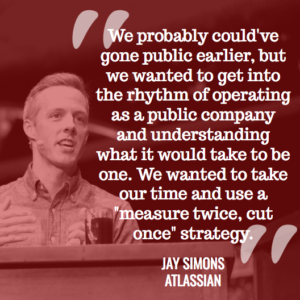
Jay: Yeah, sometimes with the board, sometimes just internally, trying to understand what it will be like as a public company, and getting into the rhythm of acting like that, was part of the maturation in growing up that we felt we wanted to do.
I think there’s a lot of companies that don’t do that, and they figured it out afterwards. I think for some of them that’s not OK, for some of them, it is OK. For us, we felt like we wanted to take our time. It’s a “measure twice, cut once” strategy.
Jason: Atlassian had the luck. It could have IPO’d early if you’d wanted. Anyone can have a great IPO when you hit $100 million in revenues. The big round you did was secondary, so you clearly didn’t need the money, right?
Jay: Right.
Jason: It’s so confusing to hear the noise about, “Uber should IPO,” what does Atlassian get out of the IPO? You get a currency for M&A, but let’s put that aside. It’s easier to buy a company. Apart from that, what have you gotten out of that? The employees got liquidity. There was some liquidity already.
Jay: That’s certainly one thing, employees get liquidity. There’s other ways for employees to get liquidity, but even if you’re taking secondary rounds from private investors, eventually you’re setting a fuse that at some point, whether you’re Atlassian or Uber, you’re probably going to take the public market stage.
Jason: Eventually you’ve got to, yeah.
Jay: You’re eventually leapfrogging private secondary after private secondary. You’re getting employees liquidity, and that was certainly important to us. We had employees that had been with the company for over a decade.
In fact, we took all of the 10-year employees to New York to celebrate the IPO. There was a big gaggle of them. There’s a bunch of people that have worked really hard along that journey. That’s one.
Certainly it’s a branding event for any company that takes the public stage. It was an important one for us. We’re really proud of the customer franchise we’ve built, but we’ve barely scratched the surface. There’s a lot of companies around the globe that haven’t yet heard of Atlassian, that haven’t heard of our products. This is an amplifier for that.
I believe, and we believe that the buzz…
Jason: Is that true? I know it’s true, because you said it, but that’s interesting. Even today, for your target customers, you feel like brand awareness isn’t in the 90s, or at some level?
Jay: Remember, we’re always evolving our target customer base.
Jason: You are, yeah.
Jay: We started at a very early age just targeting developers in software and technical teams, and then expanding into IT, and also now expanding into every business team inside of a company. That, the amplification of brand is going to help that, help us attack that bigger opportunity. That’s a second thing.
I think the third thing is, we believe that the best run companies are public companies. Operating as a public company applies some pressure, but also, I think, some discipline to how you run your business.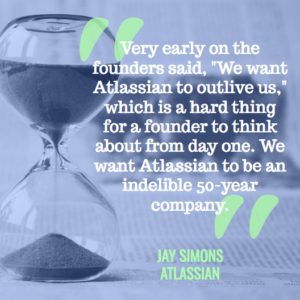
We’ve always believed, from very early on the founders basically said, “We want Atlassian to outlive us,” which is a hard thing for a founder to think about from day one.
Jason: That’s pretty crazy.
Jay: We want Atlassian to be an indelible, 50-year company.
We might not be selling JIRA, Confluence, or HipChat 50 years from now, but we want Atlassian to be building and selling something. That’s their goal.
I think if you think about that journey, taking the public stage, it’s hard to imagine 50-year indelible companies that haven’t taken the public stage. I do think it helps with operational discipline and help build better companies over the long run. That’s sort of the package of reasons. Also for us a lot of people confuse an IPO with a terminus event, like it’s the destination.
Jason: [laughs] It’s a moment in time.
Jay: If you’re building a 50-year company, it’s just a mile marker. It’s not like people at Google today are talking about the IPO. It’s not like people at Microsoft are talking about when Microsoft went public in 1986. It’s just Microsoft, Google, and Facebook now are very big companies that focus on growth and the 10, 15, or 20 years in front of them.
I should say, by the way, that raising money is another really important, kind of the fourth important reason. Atlassian had been bootstrapped from the very beginning, had never raised institutional capital on its balance sheet.
We did two secondary rounds, one with Excel in 2010, and one with T. Rowe Price in 2013. For us, those were really intentional decisions. In part it was about secondary liquidity for employees and founders that had worked for a long time, but it was also, until 2010, the board was effectively just the two founders.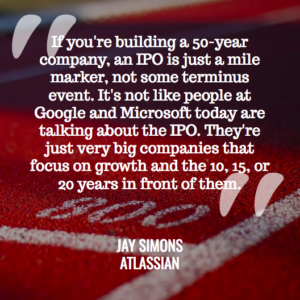
Jason: Those are quiet board meetings. [laughs]
Jay: Yeah. We had really no outside advisors that were active and involved, and thinking about growth and hurdles we’ve been through…
[crosstalk]
Jason: Let’s chat about that just a little minute, because that’s not an uncommon scenario, because we have a lot of bootstrap folks here that got to a couple million in revenue. I’ve learned a lot in the companies that I’ve posted on or I’ve invested in. What do you think about having no one, no one on the board, no one outside to challenge you?
Jay: I think it’s important to have outside perspective. For us, we had just gone through 2008, 2009, so global financial crisis.
Jason: Yes. Those were challenging times.
Jay: We were at a phase of growth where I think we’d had a bunch of advisors, informal advisors that I think had provided input or guidance to the company over time, but not a formal, somebody that was really thinking about the phases of growth that we were either going to bump into or leap over.
That was Excel. Excel in the secondary round we did in 2010 gave us that. Rich Wong sat on the board. Super, super incredible guy.
Jason: Yeah, he’s great.
Jay: I think provided a lot of great advice and guidance, also opened up some networking channels that might have been difficult for us to open up at the time in terms of people we wanted to hire and add to the board.
Also became kind of a branding opportunity in 2010. Atlassian had been this company that had flown under the radar for a long time. The $60 million round in 2010, even though it was secondary and didn’t hit the company’s balance sheet, it was the single largest venture capital round that Excel had done.
Jason: It caught my attention.
Jay: At the time, so it was like, “Wow, here’s a company that people hadn’t heard of. Why is all this capital going to even, at the time, just founders? Why is it going to the company?”
In 2013, the other secondary round we did was with T. Rowe Price, and that was intentional because what we wanted was, again, this is part of the “measure twice, cut once approach.”
We wanted to understand how big institutional investors thought about the business. What we wanted with T. Rowe Price, even though that round, it was like 130, went all to employees, again, didn’t go to the company.
What we got in exchange for that was a deeply experienced institutional firm that we could spend time with and understand the questions that they asked, how they thought about our business, and what that would look like, because we were about to take the public stage and, by several orders of magnitude, add a whole bunch of other institutional investors that would think about the business the same way.
Jason: I want to talk about a topic that you’ve talked about ad nauseam, but I want to take an approach that’s focused on the founders, which is sales-free models. You have a fascinating background, if people don’t know it, because you have an enterprise sales background. [laughs]
Jay: Yeah.
Jason: For real, right? I think you’ve carried a bag, or you’ve come close to it, right?
Jay: I did. Started in enterprise software carrying a bag.
Jason: Carrying the bag.
Jay: The first seven years of my career was a hard slog in enterprise sales.
Jason: I want to just hone in on a couple things on it, specifically. Everyone in the world, no matter, and I love sales, and you have a passion for it. We’d all love to not have a sales team, if for no other reason than cost and overhead management.
It’s alluring, the idea of having this, but I want to dig in on a couple things. First of all, to be clear, it’s not a human-free business. We have a lot of happiness offers. We do have a lot of folks at Atlassian engaging with that…
Jay: Sure, absolutely.
Jason: A lot of folks. It’s hundreds of folks. Do you have a rough number?
Jay: And we have a channel, which we’ll get to in a second.
Jason: We have a channel as well. In their own way they’re selling hard, the channel.
Jay: Absolutely.
Jason: How does that, and I know you’ve thought a lot about this. In my experience, as the deal size goes up, you’re leaving money on the table, which may be OK. It may be a tradeoff, because Atlassian was minting cash, and many peers are not.
Is that clear to you? You have I don’t know how many customers in the S1 that are over 50K ACV, but it’s a lot. I think it was close to a thousand?
Jay: Close to a thousand.
Jason: 50K customers don’t mind being sold to, even if they are IT, or product-centric, or dev-centric. They don’t mind being sold to, I think. For folks here, what’s the trade off? What are your zen learnings? Obviously Atlassian’s a huge success, but what’s your advice to folks?
Jay: First of all, it may be possible, it may be probable, in our business, that you’re achieving the same lifetime value of a customer over a longer period of time. People always say to me, “Don’t you think if you spent a bunch of time on a particular account, that you could pull a lot of that revenue forward?”
Jason: Yes.
Jay: I do believe that’s true, but oftentimes when you do that you create worse long-term value for your company, better short term value, because you’re pulling all that revenue forward, so even in the case where we’re trying to get to $1 million in annual customer spend, we do that over a period of years at far more efficient, less upfront cost.
The other thing is that when you think about the recipe for our business model, it’s not as simple as, “Don’t have traditional quota-carrying sales reps.” It’s not that simple, at all. When we think about our model, first of all we started with the size of the market.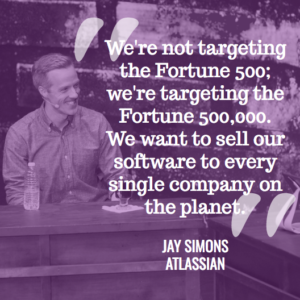
For us, the market’s huge. We’re not targeting the Fortune 500. We’re targeting the Fortune 500,000. We want to sell our software to every single company on the planet. If we were targeting Fortune 500,000, we would have a completely different model. We’d be Workday.
Also, the nature of how we enter inside of an organization is different. Companies that buy our software…When you buy Workday, as an example, you’re only going to buy one of them. You’re not going to have multiple HR management systems. You’re not going to have multiple general ledgers.
You buy one. That is a very explicit top down sale. I’m going to talk to executives in the company, and there’s a whole business case around the one thing that we’re going to have.
We sell team software. First of all, we enter inside of the team, and you could have lots of teams that use different technologies, right?
Jason: Yeah.
Jay: That’s OK, too. We want to cement that one valuable landing spot, and then expand over time. Top down, it was really hard to do that way.
First, pick a market that’s huge, and then build the product to reach that market. For us, we focused a lot on building a product that teams or customers could get started in minutes, and we priced it for affordability. We thought, “OK, if it’s a really big, expensive cost, we’re going to have to explain why it’s expensive.”
You remove friction with price, and you create still future opportunity you can capture over time. We want the ability to expand either with additional usage and seats, or we want the ability to expand with additional products that we could sell the customer in the future.
And then the fourth point, this is all a careful chemistry. The fourth point is you have to remove as much friction as possible from the customer’s path. This is what’s really hard in a traditional sales model. For us, removing friction meant, “Publish your price. Publish every single price. Don’t have to contact us to figure out how much it is, because that is a friction point. Publish every single price.”
Let the customer try it on their own terms, without needing to engage us to figure out what they’re trying to do with it. Invest as much as you can in the product to make sure that that trial experience converts without a lot of handholding.
And create, as you mentioned, we’ve got a number of people inside of the business, we call them product and customer advocates, that are focused on helping answer questions the customer has. We say to every single customer, “If you need extra TLC, let us know. We’ll bend over backwards to help you.”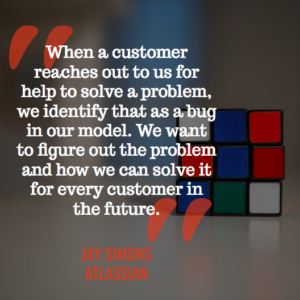
The difference is that in our model, we identify that as a bug in the model. It’s something we need to fix in the future. We don’t want every single customer, if we’re targeting 500,000, to have to raise their hand, and for us to engage. We want to figure out what was the problem that that customer needed human help solving, and how do we solve it for the next 499,999 customers in the future.
It’s been 13 years, where we’re consistently improving, refining, improving, refining, experimenting. I’ve said this before, we do a lot of experimentation with traditional approaches. “What happens when we pick up the phone and call every customer, and really try to sell hard, really try to pull all that value forward?”
You can do it, but the challenge is the cost scale. When you look at a lot of SaaS companies, that’s where they get into some challenges, where your sales and marketing expenses are way out of band with your topline growth.
The trade off, remember, in most business is something has to give for you to make money as a business. You either give on sales and marketing costs, you either make more money in topline, or you give on other functions of the business, like R&D.
It always seemed strange to me that for a SaaS company, for a software company building product, that your sales and marketing costs would be twice what your R&D costs would be. If you look at a lot of companies, at least from our perspective, they have it inverted.
We spend twice on R&D that we do in sales and marketing.
Jason: That has made…
Jay: Sorry, that was a long ramble there.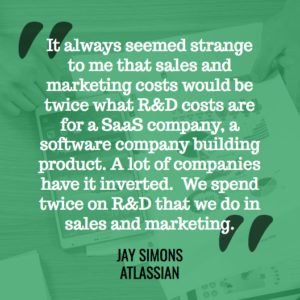
Jason: Let me dig into that a little bit for the founders here. Once we all get to a million in accumulated revenue, we figure this out. Oh my gosh, sales and marketing, even if it’s accretive, it should be accretive if it’s done right, but it’s expensive, and it’s hard.
I feel like Atlassian is the new Basecamp. Let me explain what I mean by that for founders.
A couple of years ago, before you raised the 60 million, or whatever, I used Bitbucket, but I didn’t even know that it was an Atlassian product. [laughs] All founders would talk about, “I want to be like Basecamp. I want to be on my own, and build cool software, and I don’t need sales people.”
Now everyone wants to do the Atlassian. Now we get it, now that Atlassian’s huge. We all want that, but when you meet with founders, where do you advise them that, “Hey, we can’t all do this”?
Salesforce is a success. Workday is an extreme, because we’re all doing eight-figure and up deals, but when you meet with founders, where do you tell them, “Hey, slow down. Even if you’re doing a developer-centric product, don’t copy our model.” What’s your advice to them?
Jay: Part of it is the ingredients that I mentioned earlier. Think about your market. If I’m ServiceNow, which is a great company, and really only trying to sell a massive piece of software for a massive project to 2,000 companies.
We have an equivalent product that we’re trying to sell to 200,000 companies. The strategies that both of those companies employ are vastly different. In any given period, we’ll probably have as many ServiceDesk customers.
Jay: It was a new…
[crosstalk]
Jason: The next generation of the Web was branded, right?
Jay: Right. AdWords was effectively a new approach to reach people that were looking for something that you had. They really instrumented that effectively, but the first handful of prospects, we spent a lot of time with in 2002.
I think because they were engineers, they were focused on doing what I mentioned earlier, constantly trying to improve. “Why are we engaging? What questions are we answering? How do we answer that to begin with?”
This is where I tell founders, “Think about that. Once you hire your first salesperson, is all of the energy, the emphasis, going to be on scaling the human approach, or figuring out how to take what you can from that human approach,” because it might still scale to a certain point.
But if your market is 500,000 companies, or 100,000 companies, or 2,000 companies, is that the most efficient, best approach to reach them?
Jason: Yeah.
Jay: Everything needs to be calibrated, market, pricing, products. It’s not as simple as traditional salespeople or no traditional salespeople. It’s a lot more complicated.
Then the last thing I’d mention is we have a channel. We chose really early on that where there were opportunities that needed more human touch, how could we do that the most efficiently? In some ways, we ripped the Microsoft playbook of the ’80s and ’90s, which is we hired…There’s a firm, ServiceRocket, in Australia, that, I think, has been a partner of ours for over a decade, and serviced in New Zealand.
There were partners in France and Germany. We didn’t speak French. We didn’t speak German, but we had people that did. If you think about it, our sales force, we’ve got 2,000 sales people that are out in the field. They’re not employed by us, but they effectively do the same job.
Jason: They’re a sales team. They’re salespeople.
I’d love to talk more about that, but I want to talk about to a related point. I tried to google this. I couldn’t find it, but I remember a few years ago, someone on the senior team said, “One of the most important things that Atlassian ever did was have more than one product,” right?
Jay: Yeah.
Jason: I haven’t looked what the revenue mix was in the IPO, but you’ve got at least three of the four that are material, right, that are over 10 percent of your revenue, I think?
Jay: Correct.
Jason: Boy, as a founder, that’s intimidating. Especially for the management team, how do you focus on four products? You can’t put 100 percent of your time in it. It’s a myth. You have to force rank things. Isn’t number four going to fail as the competitors get more aggressive?
How do you juggle four, even without the sales team, which helps a little bit? This way you don’t need four sales teams, right?
Jay: Yeah.
Jason: Isn’t it a challenge as well as an opportunity? [laughs]
Jay: It totally is. I think…
[crosstalk]
Jason: What’s the advice? What’s the advice for this?
Jay: Hindsight being 20/20, it’s easy to look back and say, “That was a great decision.” The founders will say, they started Atlassian with JIRA in 2002. Confluence, which is the next to biggest products, they shipped in 2004. They did it really to scratch their own itch.
At the time, they were using a bunch of open source wikis, and they didn’t like them, and they thought, “We could build one better.” Probably, I think at the time, there was a debate between the two founders around, “Man, shouldn’t we really just be doubling down on this? This is a huge opportunity.”
I think in hindsight, it was exactly the right decision to say, “Let’s sort of divert engineering focus a little bit, build a second product, identify, discover whether or not we have a product market fit for this thing,” which it did, and then kind of double down on two products.
Had we not done that, Atlassian would be a vastly different company. Atlassian JIRA is a great product. It’s a big product, but it is not…I think Atlassian is a much bigger company as a result of expanding product strategy. That’s sort of the first part, and again, that’s isn’t going to work…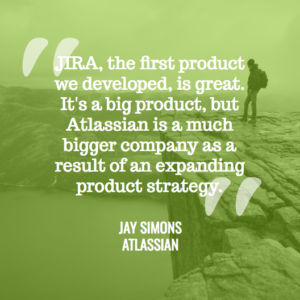
[crosstalk]
Jason: But challenge me a little bit. Imagine…But JIRA is a big…I don’t want to get anything that hasn’t been disclosed. With the revenue breakdowns, are they published publicly or not?
Jay: No.
Jason: But JIRA is a big platform, right?
Jay: Yeah.
Jason: What if, just hypothetically, you’d done nothing but JIRA? JIRA wouldn’t be even better? Wouldn’t it be even more robust?
Jay: Not.
Jason: It has high market share, but wouldn’t it have more market share? You don’t think so?
Jay: It’s a hard hypothetical debate to have. The other part of the question that you ask that I was going to answer is, for us, it really hinged around product strategy. We think about the team.
For us, every team, irrespective of whether they’re building software, selling, or marketing, needs a way, a place, to organize what they’re doing together as a group. They need a place to discuss it, which is what HipChat does.
They need a place to create and share content, which is Confluence. That’s sort of trimaran, I think of that, as the three legs of a team collaboration stool. We’ve really focused on of building out all three legs. I think we’re less of a company if we only have one or two legs.
Jason: I should know this, but I don’t. How much organic or inorganic cross sell do you get across the suite?
Jay: A lot.
Jason: A lot, and how does that happen? Describe it, because we all like to think that cross-departmental or cross-product expansion happens, but in my experience, usually the HR department does not go to the VP of sales and tell them to go try this product they love.
Different products are same as different departments, but you may have a CTO that loves HipChat, but they didn’t use JIRA at their last company, and they don’t want to learn JIRA. How does that happen?
Jay: For us, a couple of ways. One, there’s natural network effects built in into our software, because we’re team-oriented. Remember, even if you are in marketing, you’re not part of just of a marketing team. You’re part of a whole bunch of different projects around your organization where you get exposed to what we do.
When you do, and you like it, you pivot around to the other teams you’re working with and say, “Man, what they’re doing over there that I was a part of, I really liked. Let’s start using that.” That’s how we get into the HR.
We don’t have necessarily have to land inside of HR. We can expand, because someone in HR gets exposed to JIRA, Confluence, and HipChat, and says, “Man, the rest of us have to be doing what they’re doing.”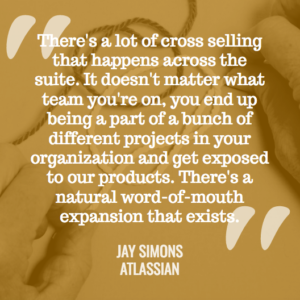
There’s a natural organic word-of-mouth expansion that exists. We try to aid that with some things that all of us do, like email. We try to say, “Hey, did you know you who are…”
Jay: …they are, so end user NPS is probably the important leading indicator of future growth. If your end users are unhappy, and even if I’m a Workday user, and if I’m not happy, long term, that’s not a great thing for a Workday, even if the HR person loves them.
We sort of think about that in that way. Then, we put a bunch of hooks in product to point people to other things that they could do, or use, or trial. If you think about it with, we got 50,000, 54,000 active customers now, that is the best way to canvass that opportunity and to expand it. It wouldn’t necessarily be to pinpoint one after another after another.
Back to R&D, we invest a lot in trying to figure out, “What is the most efficient vehicle for us to expand the fastest biggest audience?” Everything we do is about that.
Jason: One last question on this. I’d love to spend forever on it, but I only have a couple…For the core four products, on the management team, when you’re thinking about product strategically, how much time do you spend on each? How do you divide up?
There’s only so many hours in the day, so how do you think about force ranking your time and effort? Is it just based on revenue? How do you do it? Do you have different GMs? I’m sure you have GM-free product, right?
Jay: We do. It’s based on a combination of market opportunity and market strategy, competitive strategy. The priorities are going to shift around depending on the given market, or product, or priority. We do focus on making sure…
The thing for us now, and this is probably true when we were a lot smaller, too, you think about the quantum that a product’s going to contribute, and the size that that can grow over time. In our model, we often talked about, early on, used this metaphor of a snowball rolling down the hill. If you think about it, every new product is sort of a new snowball.
What we try to do is you either launch more snowballs, so they start rolling down, or you take the overall slope, which is the investment that we would make in automation or end user engagement, or smart recommendation strategies in a product, and that’s steepens the slope.
The steeper the slope, the more any individual ball, if we know that it’s going to get all the way to the bottom of the hill, it’s got a big market, the more snow it accumulates. We’re not going to drop balls at the top of the hill that we don’t think are going to turn into big snowballs, and then at the bottom we can build snowmen. That’s butchered, but…
[laughter]
Jason: No, it’s a good one. One other thing about complexity. I want to make sure before we run out of time. Atlassian is interesting, because it has multiple products. It’s also interesting to me that you have multiple ways that you sell that software.
You have on prem. You have services. You have channel. You have hosted SaaS. You have about every box at the moment that you could check on the panoply of ways to deliver software directly, indirectly. High level, my view is, “Does it even matter?”
A lot of founders are like, “I don’t want to have services. I don’t want to have proserv. I don’t want to do this, because I got to be in this narrow box,” but Atlassian, it’s evolving. It’s going to become more and more SaaS over time, but today it’s the whole kit and caboodle, right?
Jay: Sure. The answer to that question again, largely is answered by our origin and when we started. In 2002, we started in a market where I think SaaS was a less common adoption pattern, certainly in 2002.
Jason: Even scary. Scary.
Jay: Yeah. We started shipping behind the firewall server, service software, and because we started there, we’re really good at it. We knew how to do it and do it. We, I think, read the tea leaves early enough, where we started a SaaS businesses now, close to 10 years ago.
Our SaaS business on its own, it’s a really big SaaS business, but I think we figured out, which is hard to do, how to thread both of those needles, and not have it be a distraction, and not have to be a weight that slows the company down.
It’s a tricky thing to give people advice. “Should I have started a SaaS business? Should I go behind the firewall?” There could be some tradeoffs there, that I think every single company needs to think about carefully.
Overall, the market is, as most of us know in the room, it’s moving towards cloud. You have to look in your individual market segment.
Jason: But with flavors in cloud, and private cloud, and hybrid cloud, so it’s getting simpler, and then it´s getting more complicated as it gets simpler.
Jay: It’s been good for us. We’ve been able to attack a wider segment of the market, because we’ve figured out how to support both deployment choices, and, again, in removing frictions which is sort of the mantra of the business. We simply present that to the customer as a free choice they’re going to make on their own.
If they’ve got an IT department and an infrastructure, and they’re more comfortable installing and managing the server there, great. Let them knock themselves out. If they want us to do it, and they want us to run it on our cloud platform, great. We don’t care either way.
Jason: One last question. I feel like I’m just getting going on this stuff I want to learn, but I want to… Atlassian’s blown through 100. It’s blown through 300 million. I have this thesis of how far you can squint and see on the horizon. I think you can squint about 10x, and you can feel about 3x.
You’re looking at a billion, which is a scary number, probably. How big was Atlassian when you joined in terms of revenue?
Jay: Like 20.
Jason: Billions are a big journey from… What’s going to change at a billion? Do you have a sense? Does anything have to change, outside of bringing in better talent? What does the world look like out there at a billion in revenue? Do you know?
Jay: If I had crystal ball that told me all of that…
Jason: You know it looks like next quarter. [laughs]
Jay: Yeah. I would just say, absolutely there’s going to be change. There’s change for every company as it crosses a bunch of big milestones. You know there’s going to be change around the size of the company, the number of Atlassians that are working together.
There’s going to be a change, potentially, in markets that we’ve thrust into, and how our products need to evolve. I can’t predict all of the changes, nor tell you exactly what they will be, but, yeah, there certainly will be some.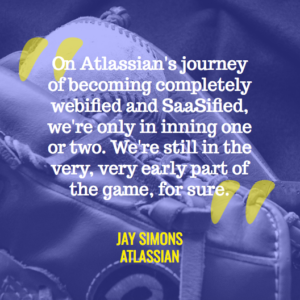
Jason: Let me ask you a final related question to it. In this whole journey of webification of everything and SaaSification of everything, as Atlassian’s gone from B to D, to product, to IT, in this whole thing, what inning do you think we’re in, of this journey, for everything to become webified and SaaSified?
Where are we? In second inning, the fourth inning? How does it feel having Atlassian been on this journey for a while?
Jay: Inning one or inning two.
Jason: Inning one or inning two.
Jay: Yeah, the very, very early part of the game, for sure.
Jason: Very early, right?
Jay: Yeah.
Jason: A few down days in the market, no big deal, right?
Jay: No big deal.
Jason: [laughs] All right my friend, thank you very much. This was epic, yeah.
Jay: Thanks.
[applause]
